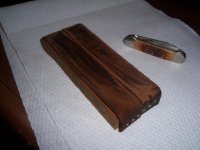wingriderz
Member
I know I have seen some threads on sharpening Now that I am retired I am going to get it a go . I have never been great with wet stone but those that do any advice would be great. I am sharpeing lock blades that pretty much stay in rear pocket. I don't use these for E D C chores. A case peanut or swiss rides in front pocket for that. The knives are Sogs, and few others. I am looking for tip wet stone wise thanks
Last edited:

